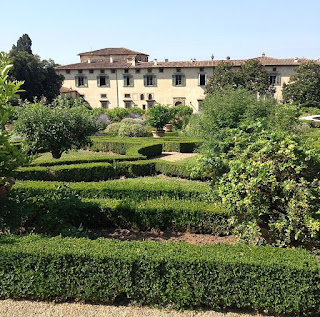NEW - Maria Salviati - noblewoman
Florentine whose line included kings of France and England
The noblewoman Maria Salviati, whose descendants include two kings of France and two kings of England, was born on this day in 1499 in Florence. Salviati was the mother of Cosimo I de’ Medici, the first Grand Duke of Tuscany and a powerful figure in the mid-16th century. Her descendants included Louis XIII and Louis XIV of France, and Charles II and James II of England. Married for nine years to Lodovico de’ Medici, who was more widely known as the condottiero Giovanni dalle Bande Nere, Salviati herself had Medici blood. One of a family of 10 children, her mother was Lucrezia de Lorenzo de’ Medici, who had married the politician Iacopo Salviati, who was from another major banking family in Florence. Maria’s maternal grandfather was Lorenzo the Magnificent, the Renaissance ruler who famously sponsored Michelangelo and Botticelli. She was married to Giovanni dalle Bande Nere when she was 18, having known him since she was 10, when he was placed in the care of her parents following the death of his mother, Caterina Sforza, daughter of the Duke of Milan. As a professional soldier, her husband spent much less time with her than she would have liked and Cosimo was their only child. Read more…
_______________________________________________________________
Gino D'Acampo - celebrity chef
Neapolitan inherited talent from grandfather
The celebrity chef Gino D’Acampo was born on this day in 1976 in Torre del Greco, a conurbation of around 90,000 inhabitants within the Metropolitan City of Naples. Based in England since 1995, D’Acampo is scarcely known in his native country yet his social media pages have more than two and a half million followers. The author of 11 books on cooking, his numerous television appearances include several series of his own show, Gino’s Italian Escapes. He owns a number of restaurants and pasta bars and is the co-owner of a company selling Italian ingredients. His success is all the more remarkable given that he had to rebuild his life after being convicted in 1998 of burglary, an episode that took place while he was working as a waiter. He described the incident as a mistake he vowed never to repeat and has since spent time helping disadvantaged young people to learn from their mistakes. Born Gennaro d’Acampo, he grew up around food. His grandfather, Giovanni, who had been head chef for a cruise company, owned a restaurant and although he had early aspirations to become a doctor or a dentist, he eventually enrolled at the Luigi de Medici catering school in Naples. Read more…
______________________________________________________________
Lady Blessington’s Neapolitan Journals
Irish aristocrat fell in love with Naples
Marguerite, Lady Blessington, an Irish-born writer who married into the British aristocracy, arrived in Naples on this day in 1823 and began writing her Neapolitan Journals. She was to stay in the city for nearly three years and her detailed account of what she saw and who she met has left us with a unique insight into life in Naples nearly 200 years ago. Lady Blessington made herself at home in Naples and thoroughly embraced the culture, attending local events, making what at the time were adventurous excursions, and entertaining Neapolitan aristocrats and intellectuals at the former royal palace that became her home. Those who know Naples today will recognise in her vivid descriptions many places that have remained unchanged for the last two centuries. She also provides a valuable insight into what life was like at the time for ordinary people as well as for the rich and privileged. A society beauty, she came to Naples during a long European tour after her marriage to Charles Gardiner, the first Earl of Blessington, and immediately became fascinated by the local customs, food and traditions. She also visited Ercolano, Paestum, Capri, Ischia and Sorrento and made an ascent of Vesuvius on an ass. Read more…
_______________________________________________________________
Michele Casadei Massari - chef and restaurateur
American dream from small beginnings
The chef and businessman Michele Casadei Massari, who is the owner and founder of the Piccolo Cafe and the Lucciola restaurant in New York City, was born on this day in 1975 in Riccione, on the Adriatic coast of Emilia-Romagna. Massari had planned to become a doctor but abandoned his studies in order to pursue his dream of cooking in his own restaurant. After working as general manager and executive chef of a restaurant at a holiday resort in Sardinia, Massari and an old school friend decided to go it alone and chose to start a business in New York. They began by selling coffee from a kiosk on Union Square in Manhattan before graduating to a cafe selling traditional Italian food as well as salads, panini and egg dishes. Massari and his partner opened their first Piccolo Cafe in Third Avenue, a couple of blocks from Union Square in 2010. Now they have four branches of Piccolo Cafe and a restaurant, Lucciola, that specialises in the cuisine of Bologna and Emilia-Romagna. Only six years old when he saw the inside of a restaurant kitchen for the first time, Massari acquired his love of cooking from his grandfather, ‘Nonno Gigi’. Read more…
Home













